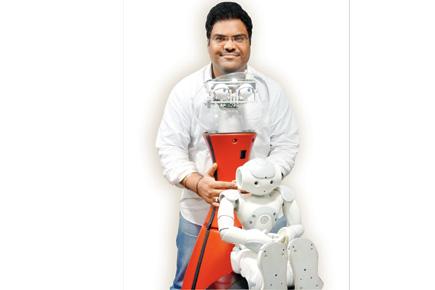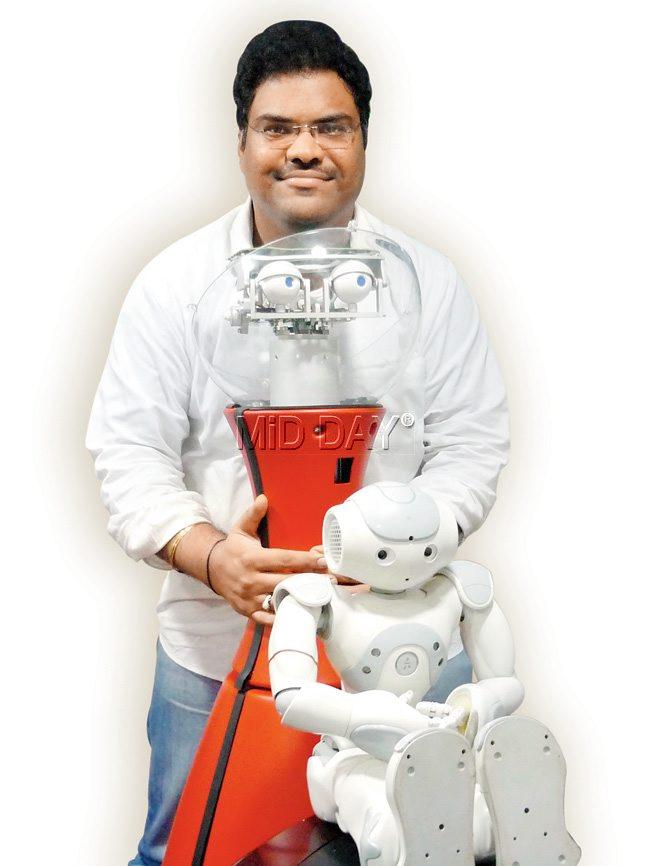Crowdsourcing and co-creating web portal Robolution.me, which launches on February 5, urges people to air their issues online, while inviting tech solutions to solve them. Sasi Gade, engineer and founder of the portal, tells Anu Prabhakar how he aims to bring out the ‘problem solver’ in everyone through this venture and why he wants to build a break-up robot

Sasi Gade with two robots, including Abhirami (in white).
Minutes after executing killer dance moves at the cancer care centre St Jude India Child Care Centre in Kharghar, Abhirami slipped on the slippery floor. The children peered over their white, sterile masks and hovered around her. “Their comments were incredible,” remembers 30-year-old Sasi Kiran Gade, director and CEO of Gade Autonomous Systems Private Limited. “They didn’t say that she stopped working. Instead, they said she must be sleeping.”
ADVERTISEMENT

Sasi Gade with two robots, including Abhirami (in white). Pic/Anu Prabhakar
We, on the other hand, find something else that’s far more incredible in the anecdote. That Abhirami is a robot who had just finished playing with the children, using flashcards, before the crash. And that ‘she’ can also pull off a flawless suryanamaskar.
The emotional bond that the children forged with the robot convinced Gade of the need to solve issues using technology. “And that’s how I thought of the crowdsourcing and co-creating web portal Robolution.me,” says the entrepreneur, when we meet him at his office in Malad.
A space for problem solvers
Robolution.me, which will go live on February 5 (a teaser for the portal was out two weeks ago), is Gade’s effort to bring out the ‘problem solver’ in everyone. “The portal will invite people to voice the issues that they face on a day-to-day basis — it can be anything from incessant honking on the roads, to finding out their most annoying problems. It will also seek opinion and ideas from people on how they would like to solve these issues. Popular and doable ideas will be chosen and shaped in the form of a ‘challenge’,” says Gade. This will then be prominently displayed on the portal’s home page, along with a well-articulated video on the issue and clues, including details, courses and books that one can refer to, to solve it.
“Once someone has a prototype (of a gadget) ready that can solve the problem, they have to submit a video about the same to us. If they want to make money out of it, they can put the gadget’s programming or algorithm on the portal’s store (which runs on the lines of App Store) where interested parties can purchase it and develop it further,” elaborates the engineer. “So, say, you want to find out the discount rate of something and the salesperson is clueless. Why can’t we have bar code readers everywhere?” he asks.
By the end of this year, Gade hopes the portal will help churn 10 to 15 prototypes that can help solve, what he calls, real world problems. “We will co-create solutions with the problem solvers and mentor them in terms of the technology and skills one needs to solve a challenge. We will also connect them to companies that are on the lookout for such talent. So the bottom line is, if you don’t want to be stuck in a R3 lakh job and want to do something different, this will force the world to look at you in a different light” he elaborates.
In the first year, the portal plans to develop prototypes that will target six sectors — special education, rehabilitation, fitness, elderly care, common sense (or daily living) and retail. “If a solution grabs eyeballs at the store, we will also help the problemsolver look at mass production,” he adds. Also, once the portal takes off, Gade plans to spend time in villages, towns and cities to look at the issues there, so that he can crowdsource ideas and co-create solutions to solve them.
A break-up robot
While running his company for the past four years, Gade has closely worked with interns. He opines that although young Indian designers are skilled and talented, they do not know how to put them to good use. “They lack direction,” he says, while explaining the inspiration behind Robolution.me.
Another robot, meanwhile, watches us from a corner. “I am planning to install the robot at a mall in Malad by the end of next month for retail purposes. But I am still working on it,” explains Gade, who has a master’s degree in autonomous systems from a German university, where he had his first human-robot interaction. “It really opened up my mind,” he recalls.
But the biggest surprise comes when we ask the tech whiz what his ultimate invention would be. “Making a break-up robot,” he says after a pause. “Someone you can talk to when depressed or lonely.” And why did he name his robot Abhirami? “I don’t have a sister but if I did have one, my mother would have named her that,” he smiles.
 Subscribe today by clicking the link and stay updated with the latest news!" Click here!
Subscribe today by clicking the link and stay updated with the latest news!" Click here!






